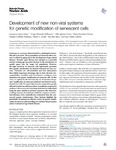Development of New Non-viral Systems for Genetic Modification of Senescent Cells

View/
Use this link to cite
http://hdl.handle.net/2183/32875
Except where otherwise noted, this item's license is described as Creative Commons Attribution-NonCommercial-NoDerivs 4.0 International License (CC-BY-NC-ND 4.0)
Collections
- Investigación (FCS) [1293]
Metadata
Show full item recordTitle
Development of New Non-viral Systems for Genetic Modification of Senescent CellsAuthor(s)
Date
2023-03-20Citation
López-Seijas J, Miranda-Balbuena D, Iglesias-Fente A, Sacristán-Santos M, Carballo-Pedrares N, Arufe MC, et al. Development of new non-viral systems for genetic modification of senescent cells. Mol Ther Nucleid Acids. 2023 Jun;32:302-217. https://doi.org/10.1016/j.omtn.2023.03.010
Abstract
[Abstract] Senescence is a process characterized by a prolonged irreversible cell-cycle arrest. The accumulation of senescent cells in tissues is related to aging and to the development of age-related diseases. Recently, gene therapy has emerged as a powerful tool for treating age-associated diseases by the transference of specific genes into the target cell population. However, the high sensitivity of senescent cells significantly precludes their genetic modification via classical viral and non-viral systems. Niosomes are self-assembled non-viral nanocarriers that exhibit important advantages due to their elevated cytocompatibility, versatility, and cost-efficiency, arising as a new alternative for genetic modification of senescent cells. In this work, we explore for the first time the use of niosomes for genetic modification of senescent umbilical cord-derived mesenchymal stem cells. We report that niosome composition greatly affected transfection efficiency; those formulations prepared in medium with sucrose and containing cholesterol as helper lipid being the most suitable to transfect senescent cells. Moreover, resulting niosome formulations exhibited a superior transfection efficiency with a markedly less cytotoxicity than the commercial reagent Lipofectamine. These findings highlight the potentiality of niosomes as effective vectors for genetic modification of senescent cells, providing new tools for the prevention and/or treatment of age-related diseases.
Keywords
Delivery strategies
Senescence
Aging
Umbilical cord mesenchymal stem cells
Gene therapy
Non-viral vectors
Niosomes
Senescence
Aging
Umbilical cord mesenchymal stem cells
Gene therapy
Non-viral vectors
Niosomes
Editor version
Rights
Creative Commons Attribution-NonCommercial-NoDerivs 4.0 International License (CC-BY-NC-ND 4.0)
ISSN
2329-0501






